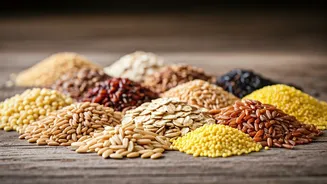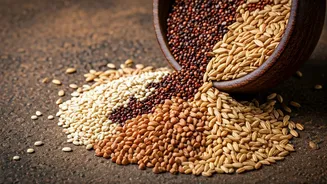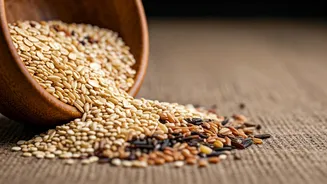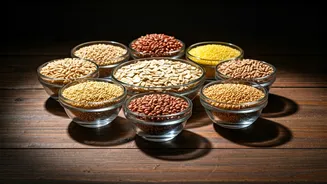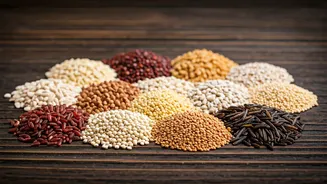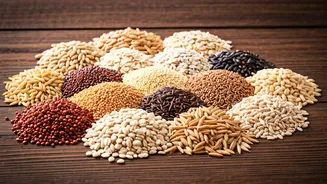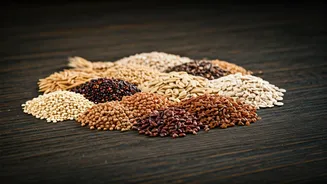Embracing Diabetes-Friendly Grains
For those managing diabetes, choosing the right foods is key. The focus is often on carbohydrates, but not all carbs are created equal. This article focuses
on 10 grains that can be part of a healthy diet, particularly for individuals with diabetes. These grains offer a wealth of nutrients in addition to their low glycemic index, which helps prevent blood sugar spikes. By including these grains in your diet, you're investing in your long-term health and well-being. These grains are more than just food; they are powerful allies in the fight against diabetes.
Quinoa: A Complete Protein Source
Quinoa stands out as an outstanding grain option. It is loaded with protein, fiber, and various vitamins and minerals. Quinoa is a complete protein, meaning it contains all nine essential amino acids that our bodies cannot produce on their own. This unique feature makes quinoa an excellent option for vegetarians and vegans. Furthermore, the fiber content in quinoa aids in slow digestion, resulting in a gradual release of glucose into the bloodstream. This property prevents blood sugar spikes. It can be easily incorporated into many dishes, from salads to breakfast bowls, offering both convenience and health benefits.
Oats: Heart-Healthy and Filling
Oats have a strong reputation for promoting heart health. They are abundant in soluble fiber, especially beta-glucan, which has been shown to lower cholesterol levels and improve insulin sensitivity. The slow digestion of oats helps to prevent sharp increases in blood sugar after eating. Oats are versatile and can be enjoyed in a variety of ways. They can be cooked into porridge, added to smoothies, or used in baked goods. Starting your day with a bowl of oatmeal is a simple yet effective way to manage blood sugar and support overall health.
Barley: Fiber-Rich and Versatile
Barley is a grain packed with fiber. The fiber in barley helps slow down the digestion and absorption of sugar, which results in stable blood sugar levels. Barley is not only beneficial for diabetes management but also contributes to digestive health due to its high fiber content. Barley can be used in soups, stews, or salads, and it adds a subtle nutty flavor to any dish. It is a very flexible grain that fits well into many meals and provides a variety of health benefits. By incorporating barley into your meals, you're making a wise decision to manage blood sugar and promote overall well-being.
Brown Rice: A Nutritious Choice
Brown rice is a much better choice than white rice for individuals with diabetes. Compared to white rice, brown rice has a lower glycemic index, indicating it causes a slower and more moderate rise in blood sugar levels. Brown rice also retains its bran and germ, which are rich in fiber, vitamins, and minerals. Fiber in brown rice helps slow down the digestion of carbohydrates, leading to a steadier release of glucose into the bloodstream. Try it in place of white rice as a side dish, in stir-fries, or in rice bowls. It is a nutritious and satisfying option for those aiming to control their blood sugar levels.
Amaranth: A Gluten-Free Powerhouse
Amaranth, a gluten-free grain, is a powerhouse of nutrition. It is high in protein and fiber, and it contains essential minerals such as magnesium and iron. Amaranth's high fiber content helps regulate blood sugar by slowing down glucose absorption. This can make a significant difference for those who want to keep their blood sugar levels in check. Amaranth can be cooked similarly to other grains, added to soups, or even popped like popcorn. Adding amaranth to your diet can be a delicious way to improve your blood sugar levels and obtain important nutrients.
Buckwheat: Not a Wheat!
Buckwheat is often mistaken for a grain but is actually a seed. It's a gluten-free option with a low glycemic index, making it suitable for people with diabetes. Buckwheat helps prevent blood sugar spikes, allowing for smoother blood sugar control. It also contains rutin, an antioxidant that has been linked to improved blood vessel health. Buckwheat can be used to make porridge, pancakes, or noodles. The subtle, earthy flavor of buckwheat makes it a versatile ingredient. Buckwheat can be a useful and delicious addition to your diabetes-friendly diet.
Millet: Easy to Digest
Millet is a small, round grain that is easy to digest. It is naturally gluten-free and contains a good amount of fiber and magnesium. Millet has a moderate glycemic index. It is effective in preventing blood sugar spikes and aiding the body in maintaining stable blood sugar levels. It can be cooked in a variety of ways, such as porridge or pilaf, or even ground into flour for baking. This makes it a adaptable and nutritious addition to any diabetic meal plan. It provides sustained energy and supports general health by providing vital nutrients.
Freekeh: A High-Fiber Choice
Freekeh, made from young green wheat, is extremely high in fiber and offers a good source of protein. Its high fiber content contributes to improved blood sugar control. The slow digestion of freekeh aids in preventing blood sugar spikes and contributes to long-term health. Freekeh has a nutty flavor and can be used in salads, soups, or as a side dish. It is also packed with important nutrients, making it a great option. It’s a smart choice for individuals who want to manage their diabetes while enjoying flavorful and healthful meals.
Spelt: An Ancient Grain
Spelt, an ancient grain, has a slightly nutty flavor and is packed with nutrients. It is a good source of fiber and contains important vitamins and minerals. Spelt has a lower glycemic index than many other grains. It helps to regulate blood sugar levels, which is important for individuals with diabetes. Spelt can be used in a variety of ways, such as in bread, pasta, or as a substitute for rice. When eaten in moderation, it helps with blood sugar control and provides a number of health benefits. Making spelt part of your diet can be a tasty and healthy way to manage your blood sugar.
Final Thoughts: Smart Choices
Adding these 10 diabetes-friendly grains into your diet can significantly help you manage blood sugar levels and boost overall health. Each grain provides its own unique blend of nutrients and health benefits, making it easier to maintain a balanced and satisfying diet. Remember that portion control, preparation methods, and meal planning all play a major role in achieving the best outcomes. Consulting with a healthcare provider or a registered dietitian can provide personalized advice for integrating these grains into your individual dietary plan. By making informed food choices and being proactive about your health, you can live a fulfilling life while effectively managing diabetes.
